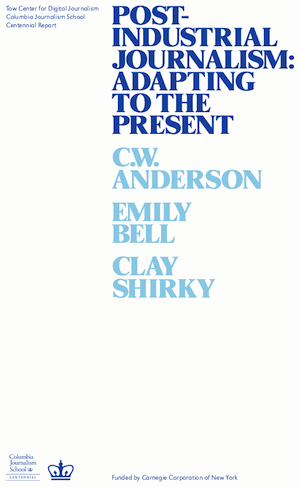 You may have already seen the new report from Columbia’s Tow Center for Digital Journalism, “Post-Industrial Journalism: Adapting to the Present.” It’s written by my friend Chris Anderson, Emily Bell, and Clay Shirky, and as you’d expect with that kind of lineup, it’s good. If you haven’t already, read it — or at least Nieman Lab’s summary of it.
You may have already seen the new report from Columbia’s Tow Center for Digital Journalism, “Post-Industrial Journalism: Adapting to the Present.” It’s written by my friend Chris Anderson, Emily Bell, and Clay Shirky, and as you’d expect with that kind of lineup, it’s good. If you haven’t already, read it — or at least Nieman Lab’s summary of it.
The report lays out clearly some of the key things happening to American journalism today — the profession and the industry that has supported it is losing the relative coherence it had for much of the 20th century and being redistributed, diffused, and displaced away from the organizations that used to occupy the commanding heights of the news media system as new actors, practices, and platforms change the context.
There’s increased competition for people’s attention and their media spend, as well as for advertisers’ budgets, many audiences are fragmenting and only partially overlapping, reduced margins leads to cost-cutting as mid-sized, middle-brow, mass-oriented general news providers have a hard time competing with new digital giants, with specialist high-quality providers, and sometimes with smaller startups. Many of these trends are also trends I’ve discussed in my own work, including my most recent report “Ten Years that Shook the Media World.”
But the report focuses on the media ecosystem in the United States. Can it also help inform discussions about what’s happening to journalism outside of the U.S.?
The answer to that has to be: “Yes, but.”
America is truly exceptional, and observations made there and lessons learned there are not always immediately applicable elsewhere.
It is clear that some of the trends described by Anderson, Bell, and Shirky are also apparent elsewhere. But their main concern is with the peculiarly American ecology that can be broadly divided into big (declining) commercial news organizations and a multitude of much smaller (often struggling) nonprofit news organizations — plus PBS, NPR, and their various affiliates.
In this environment, even though the industrial model of for-profit journalism (supported by newspapers and broadcasters) is under immense structural pressure, a new undergrowth of specialized entities are experimenting with all sorts of other, mostly not institutionalized (and often exciting) forms of journalism.
Even within the world of similarly affluent Western democracies, the American situation is, however, exceptional. Most Western European countries, for example, never had the kind of overwhelmingly commercially-dominated news industry found in the U.S., and have not yet seen the kind of experimental undergrowth seen in the U.S.
First, public service broadcasting has represented a far larger part of the overall media ecosystem. While these organizations face many strategic challenges, their funding broadly seems relatively secure and they exhibit few tendencies towards post-industrial forms of production — they are still large, bureaucratic, integrated enterprises.
Second, especially in Southern Europe, large parts of the newspaper industry have never really been commercial — in the for-profit sense of publicly traded newspaper companies in the U.S. — but are instead owned by wealthy individuals, diversified business conglomerates, or well organized interest groups, who ran their papers less to make money than to exercise influence. And as long as their patrons (Dassault in the case of Le Figaro in France, Fiat in the case of La Stampa in Italy, etc.) can afford to foot the bill, these news organizations too can maintain their integrated model.
Third, with a number of notable exceptions, most Western European countries have yet to see the emergence of a whole ecology of innovative journalistic startups akin to what we’ve seen in the U.S. With smaller markets, less of a tradition of nonprofit work and foundation funding, and fewer journalists out of a job looking for new ways to practice their craft, many of the preconditions haven’t been there yet and the startups we have seen have often struggled to survive.
These cross-national differences are important to keep in mind as those of us outside the U.S. read the many interesting reports on the present and future of journalism that comes out of there: America is truly exceptional, and observations made there and lessons learned there are not always immediately applicable elsewhere. Analytical insights have to be tested in a comparative fashion, business models and journalistic innovations translated into practice in sometimes very different contexts.
For example, while commercial news media in Western Europe feel the pressures described by Anderson, Bell, and Shirky — and journalists and media of all kind face some of the ecological changes they describe — it’s worth keeping in mind there have always been at least two motives other than profit for paying journalists to do their job: public service and propaganda. And the accelerated decline of the private, for-profit model does not necessarily entail the collapse of the two other rationales for supporting institutionalized news production.
We see this in terms of the boomlet in the U.S. of nonprofit support for public service journalism, a phenomenon the report pays a lot of attention to. It may also underlie something that the report barely mentions — the resurgence of the political proprietor, in the form of Philip Anschutz, Douglas Manchester, and the new owners of the Philadelphia Media Network.
In terms of understanding these latter developments, perhaps Americans can learn as much from European experiences as we can learn from them in other respects.
Full disclosure: C.W. Anderson is a good friend and the authors of the report are kind enough to thank me in their acknowledgements. Oh, and I also got my doctorate in communications from the Columbia School of Journalism.